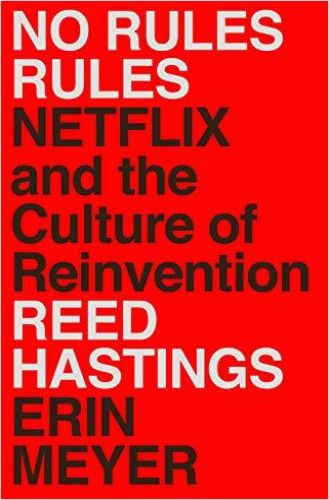Reed Hastings offers a candid deep dive into Netflix’s singular and singularly successful corporate culture.

Radical Openness and Flexibility
Reed Hastings co-founded Netflix in 1997, and has been its chairman and CEO since 1999. Erin Meyer wrote The Culture Map: Breaking Through the Invisible Boundaries of Global Business and is a professor at the international business school INSEAD. Together, they bring a relaxed, candid voice to a different sort of management guide. There’s no arguing with Netflix’s success, which Hastings attributes entirely to its ever-evolving culture. The tone and substance of his advice in this New York Times bestseller underscore Netflix’s uniqueness.
Hastings revels in how Netflix’s culture embraces a “no rules” approach that enables worker freedom. The humble former DVD-by-mail business of the early 2000s now produces award-winning movies and TV shows while streaming content to more than 167 million viewers. Hastings and Meyer explain how Netflix’s culture gives it a competitive ability to adapt rapidly in the evolving digital world while inspiring employee innovation, responsibility and high performance.
Netflix is different. We have a culture where No Rules Rules.Reed Hastings
Among other honors, the 2020 Financial Times and McKinsey “Business Book of the Year” shortlisted No Rules Rules. In its review, The New York Times found Hastings to be a moral compass: “No Rules Rules demonstrates that it is not only possible to pursue both freedom and responsibility at the same time, but that for Silicon Valley and the rest of us to thrive together, it is essential.” Underscoring Hastings’s theme that culture drives everything, the CEO of Microsoft, Satya Nadella, said, “I had the privilege of learning from Reed personally and studying the Netflix culture. The insights in this book are invaluable to anyone trying to create and sustain organizational culture.”
Netflix Culture
Netflix thrives, Hastings says repeatedly, by reacting to the constantly evolving media landscape, valuing people over process and efficiency, prioritizing innovation, and imposing few controls. Hastings believes this lets people get things done quickly without cumbersome restrictions.
A fast and innovative workplace is made up of what we call stunning colleagues – highly talented people, of diverse backgrounds and perspectives, who are exceptionally creative, accomplish significant amounts of important work, and collaborate effectively.Reed Hastings
Hastings pays creative-position employees top dollar. He argues that superior employees outperform average ones by two or three times. Reflecting Netflix’s renowned pragmatism, Hastings says to give your stars raises when their market value rises. And, he maintains, if you can’t afford to pay top money to your best, fire your worst and use their salaries.
Transparency
Hastings says flat out: Open up locked areas and closed offices and tell assistants not to be guard dogs. He lets everyone read sensitive strategic and financial reports. Obviously, this requires a culture built on profound trust. Given that, Hastings wants employees to disagree with their managers. Staff members know that their job is to serve the company, not to please their bosses. Netflix’s bosses do not micromanage.
We now say that it is disloyal to Netflix when you disagree with an idea and do not express that disagreementReed Hastings
Hastings insists that employees should express their concerns if they see holes in an idea. He asserts that the people who work at Netflix should share a mutual “North Star,” a broad direction or goal against which they assess their successes and calibrate choices.
A Fundamental Question
This is not a memoir; it’s a management how-to guide. Hastings discusses Netflix’s management tactics – and its crucial gestalt: loyalty, determination, candor, willingness to be called out on mistakes, trust and financial openness – in detail – and Meyer clarifies how to embrace them in action. However, Hastings’s management ideas – and how well they function at Netflix – raise a fundamental question: Can they work anywhere else? Or, more specifically: Can an established company apply them to positive effect?
Because Hastings created Netflix and stuck with it when he could have cashed out, he discovered, somewhat to his surprise, that he had invented and was now atop an industry. Those with even the shortest memories will recall how shocking, daring and untenable Netflix’s decision to stop mailing DVDs and to go an all-streaming network seemed at the time. But evolving technology, consumer tastes and viewing habits conspired to prove Hastings right.
His prescience and the success it wrought means that anyone who comes into this company is, by definition, ready to adhere to the Netflix way. Everyone, so to speak, drinks the culture Kool-Aid and adapts to the intense work commitment and candor Netflix demands. What seems unlikely, however, is that the managers of a hierarchical, top-down company could adopt all of Hastings’s methods without starting with a big box of dynamite with which to blow their company’s culture to smithereens.
So, Hastings’s and Meyer’s manual seems far better suited to start-ups, companies run by younger entrepreneurs whose culture is still fluid, and to management students – because this is certainly a crucial text for future companies – and their professors. Surprisingly, it might also have value for parents dealing with adolescent and older children who want to escape a command-and-control household in favor of a more collaborative environment.
If you find Hastings’s approach and Netflix’s culture compelling, you may learn from and enjoy Reed Hastings: Building Netflix by Matt Burgess and That Will Never Work, Marc Randolph’s exploration of Netflix’s astonishing development.












